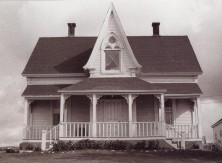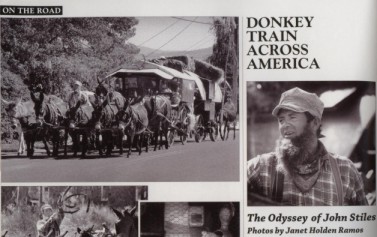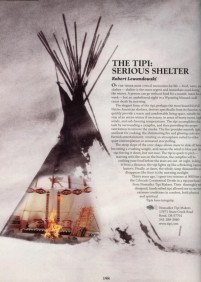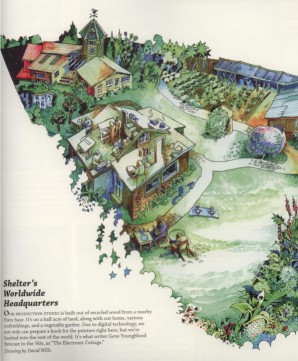
Homework: Handbuilt Shelter
Reviewed by Kelly Hart
 After
years of waiting, I finally held a copy of Home Work: Handbuilt Shelter by Lloyd Kahn in my hands. I have rarely been this enthusiastic about a book,
and not just because I am in it!
After
years of waiting, I finally held a copy of Home Work: Handbuilt Shelter by Lloyd Kahn in my hands. I have rarely been this enthusiastic about a book,
and not just because I am in it!
Ever since his first publication of Shelter in 1973 (which I also contributed to), Lloyd has been collecting imagery and stories for this eventual sequel. Shelter, a black and white over-sized catalog of unusual building, has become legendary as a book of inspiration for several generations of free-spirited home builders. The fact that it is still in print after 30 years attests to the durability of its significance. This seminal book heralded the emergence of geodesic domes and strawbale homes, as well as the influence of vernacular building styles from around the world on North American Architecture.
With Home Work, Lloyd has gone beyond the glory of his earlier work in many ways. Not only does it seem more comprehensive, but it is almost entirely in color. This is a sumptuous coffee table book that will likely not spend much time on the table, since it is so intriguing you just want to pick up and browse through it. Every page is chock full of fun, unusual, lyrical, quaint, artistic, humble, elegant, practical, colorful, whimsical, well-crafted, funky, traditional, and outlandish buildings that were lovingly built by the hands of those who reside there. All of this is presented with Lloyd's casual style of layout and commentary that is reminiscent of a scrap book. Many of the photos are actually collages of several exposures spliced together to create expansive murals.
 Flipping
through the pages of Home Work will take you back to the early
days of hippie huts and forward to the cutting edge of natural building technology.
The builders themselves are portrayed as lovingly as their buildings, with
many profiles of fine craftsmen and women sprinkled throughout. In fact, the
book begins by featuring the work of ten artisans who represent some of the
best in this tradition of owner-builders. Then a whole slew of other specific
homes are displayed in such a way that the lifestyle of their occupants is
embedded directly within the imagery. This book depicts far more than architecture;
it shows entire ways of life.
Flipping
through the pages of Home Work will take you back to the early
days of hippie huts and forward to the cutting edge of natural building technology.
The builders themselves are portrayed as lovingly as their buildings, with
many profiles of fine craftsmen and women sprinkled throughout. In fact, the
book begins by featuring the work of ten artisans who represent some of the
best in this tradition of owner-builders. Then a whole slew of other specific
homes are displayed in such a way that the lifestyle of their occupants is
embedded directly within the imagery. This book depicts far more than architecture;
it shows entire ways of life.
Half a dozen people who have dedicated their lives to the promotion of natural building are profiled, along with some of the fruit of their labors. It is in this section that Rosana and I find ourselves, with a description of our earthbag/papercrete home. What an honor it is to be part of such a fine work of art as this book. We are in the company of Bill and Athena Steen, Catherine Wanek, Ianto Evans and Linda Smiley, and others.
 Lloyd
has included examples of a variety of world-renowned photographers whose work
graces the pages with imagery from India, Mongolia, Togo, Indonesia, Vietnam,
Venezuela, New Guinea, Greece, Hong Kong, Nepal, Bali, Germany, Thailand,
and Turkey, among other places. The way these exotic places are merged with
the more familiar North American imagery makes everything seem exotic, or
in another way of seeing, it all seems quite normal.
Lloyd
has included examples of a variety of world-renowned photographers whose work
graces the pages with imagery from India, Mongolia, Togo, Indonesia, Vietnam,
Venezuela, New Guinea, Greece, Hong Kong, Nepal, Bali, Germany, Thailand,
and Turkey, among other places. The way these exotic places are merged with
the more familiar North American imagery makes everything seem exotic, or
in another way of seeing, it all seems quite normal.
 There
is a section of buildings that derive their inspiration from fantasy and whimsy.
This includes the surprising and almost garish flying concrete work of Steve
Kornher in Mexico, along with a sculptural home carved out of the Arizona
desert created by Michael Kahn, Lloyd's cousin. A Nevada house made of recycled
glass bottles contrasts with delicate tropical treehouses in Hawaii and China.
There
is a section of buildings that derive their inspiration from fantasy and whimsy.
This includes the surprising and almost garish flying concrete work of Steve
Kornher in Mexico, along with a sculptural home carved out of the Arizona
desert created by Michael Kahn, Lloyd's cousin. A Nevada house made of recycled
glass bottles contrasts with delicate tropical treehouses in Hawaii and China.
 Then
we go on the road with Lloyd, as he chronicles trips that he made over the
last 30 years. He photographed country homes that caught his eye along the
Mississippi River, lovely and simple architectural elegance in Nova Scotia,
old farm buildings of Utah and Nevada, tropical abodes in Costa Rica, and
simple living in Baja California.
Then
we go on the road with Lloyd, as he chronicles trips that he made over the
last 30 years. He photographed country homes that caught his eye along the
Mississippi River, lovely and simple architectural elegance in Nova Scotia,
old farm buildings of Utah and Nevada, tropical abodes in Costa Rica, and
simple living in Baja California.
 Continuing
with the tradition that Lloyd established in the original Shelter book, there are a bunch of images of unusual housecars or rolling residences.
My original school bus home was featured in the first book. This time there
is a donkey train pulling a rolling homestead, complete with goats and chickens.
There are several gypsy wagons, both self-propelled and not. There is log
home on wheels, as well as various buses and vans. Lots of fun.
Continuing
with the tradition that Lloyd established in the original Shelter book, there are a bunch of images of unusual housecars or rolling residences.
My original school bus home was featured in the first book. This time there
is a donkey train pulling a rolling homestead, complete with goats and chickens.
There are several gypsy wagons, both self-propelled and not. There is log
home on wheels, as well as various buses and vans. Lots of fun.
 A
chapter on living lightly features descriptions and diagrams of tipis, yurts,
tents, make-shift structures, and traditional native American homes. There
is enough information in these pages to be able to construct many of these
dwellings.
A
chapter on living lightly features descriptions and diagrams of tipis, yurts,
tents, make-shift structures, and traditional native American homes. There
is enough information in these pages to be able to construct many of these
dwellings.
 Another
love that Lloyd manifests is for old barns of all types. There are photos
and diagrams of many of these fine buildings. In fact old buildings of all
sorts attract his eye, and we see them from Oregon to Nepal, and from Hungary
back to California, where Lloyd still resides in a funky little place on the
coast of Marin County. Thank you Lloyd Kahn for such a wonderful trip!
Another
love that Lloyd manifests is for old barns of all types. There are photos
and diagrams of many of these fine buildings. In fact old buildings of all
sorts attract his eye, and we see them from Oregon to Nepal, and from Hungary
back to California, where Lloyd still resides in a funky little place on the
coast of Marin County. Thank you Lloyd Kahn for such a wonderful trip!

For Email contact go to About Us
Established in 2001, GreenHomeBuilding.com is primarily a labor of love. Kelly, and the GreenHomeBuilding team of experts, have answered thousands of questions for readers over the years, and we continue to publish up-to-date information about increasingly important sustainable architecture. If you feel moved to assist us in this work, your kind donation would be much appreciated; this can be easily done through our PayPal account:

VISIT OUR OTHER WEBSITES:
[Natural Building Blog] [Earthbag Building] [Dream Green Homes]
Disclaimer Of Liability And Warranty
I specifically disclaim any warranty, either expressed or implied, concerning the information on these pages. Neither I nor any of the advisor/consultants associated with this site will have liability for loss, damage, or injury, resulting from the use of any information found on this, or any other page at this site. Kelly Hart, Hartworks LLC.
